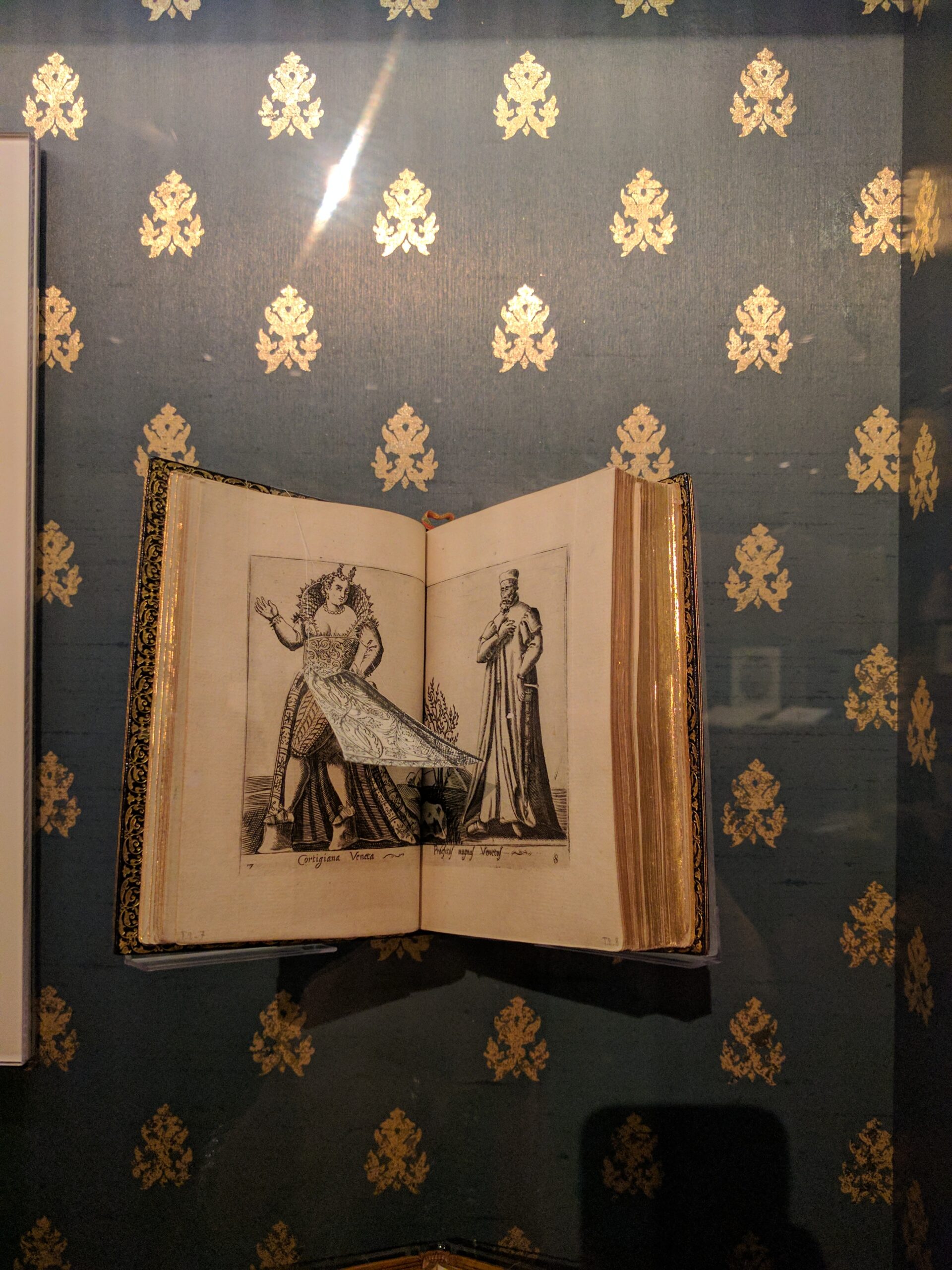Guest Contributor Exhibition Review: Love in Venice at the New York Public Library
Venice has always been a mysterious and cunning lady, from her ancient origin stories (in competition with Rome), to her annual marriage to the sea (offering profitable international trade). Depictions of that history abounded in print during the Renaissance and beyond, and the wonderful New York Public Library Love in Venice exhibition is a celebration of a culture and a place as well as of its famously erudite courtesan subculture.
Enchanting and artfully installed to evoke the light that famously drew artists to the city, Love in Venice is free to the public and will be on view at the Stephen A. Schwartzman building through August 26. Coyly lifting the veil on many aspects of Venetian life, it offers a dazzling array of books, prints and ephemera from across the special collections. Tucked into a stately first floor gallery amid mirrors and mask-like decorative accents are some 60 books, prints and even letters, each worthy of close investigation. The elegant wall cases with book cradles superimposed over a richly-patterned paper enliven the viewing experience and heighten the sense of intimacy already so central to the show. The reflective backdrop of several niches, enlarged details of prints, and handful of colored vistas and genre scenes also heighten the overall theatricality, much in keeping with the carnivalesque reputation of the region. Perhaps the most bravura performance is the letter admonishing Lord Byron for his faithlessness over a mere two weeks of absence, which was penned by an Italian mistress in high dudgeon from Venice. Nonetheless, she is, in her way, still looking forward to seeing him again! Lighthearted prints of Giacomo Casanova’s conquests make a nearby appearance as well.
This reviewer has long relished visiting the Miriam and Ira D. Wallach Division of Art, Prints, and Photographs to scrutinize one of the rarest items now on view. But there are many printed treasures on view in addition to this series of flap prints showing Venetian courtesans plying their trade (they reveal no nudity, only undergarments, tall “chopine” shoes, and canoodling couples in gondolas). Perhaps the most unique opportunity is seeing the pairing of the worship of Priapus woodcut from the 1499 Italian Renaissance fever dream of a book, Aldus Manutius’s Hypnerotomachia Poliphili. It is displayed in two examples, one printed on paper and another on luxurious vellum. Even better, the pairing shows how its suggestive content has forced a scandalized viewer’s hand. One copy is censored (with a key central detail scratched or perhaps, rubbed out), while the other, (a relatively rare survival), displays the god of fertility with his manhood fully erect.
But not all is fun and games, as the self-made image of Venice depended on harsh standards of beauty and sartorial splendor little seen elsewhere. Costume studies and parodies, and even didactic views of women (courtesans? noblewomen?) studiously bleaching their hair are all part of the fabric of Venetian life. The complicated coiffures on view in Giacomo Franco’s lovely engravings also took time to sculpt, not to mention a skilled labor force. In an era when all clothes were effectively custom couture, keeping up with fashion required the equivalent of a small army for a well-heeled woman, regardless of the company she kept (or which kept her).
Love in Venice bears revisiting, and savoring, but don’t miss the tiny Arents Tobacco Collection cigarette card in full color chromolithography, which was printed in the United States. It shows the Venetian Doge performing the maritime wedding, and suggests how widely this ritual identified Venice into the late 19th century. It also demonstrates the impressive research and deep sleuthing of Madeleine Viljoen,Curator of Prints and the Spencer Collection, throughout the New York Public Library’s extraordinary special collections. The results make for a heady combination of potent, entertaining, and very beautiful evocations of an enduringly mythical Venice.
Suzanne Karr Schmidt
George Amos Poole III Curator of Rare Books and Manuscripts
The Newberry Library
Alexander de Fabris after Pietro Bertelli, etching of “Venetian Courtesan” with skirt flap, from Diversar[um] Nationvm Habitus, ca. 1600. (Courtesy of the Miriam and Ira D. Wallach Division of Art, Prints and Photographs, Spencer Collection, New York Public Library).
Supplemental photos by the author.



